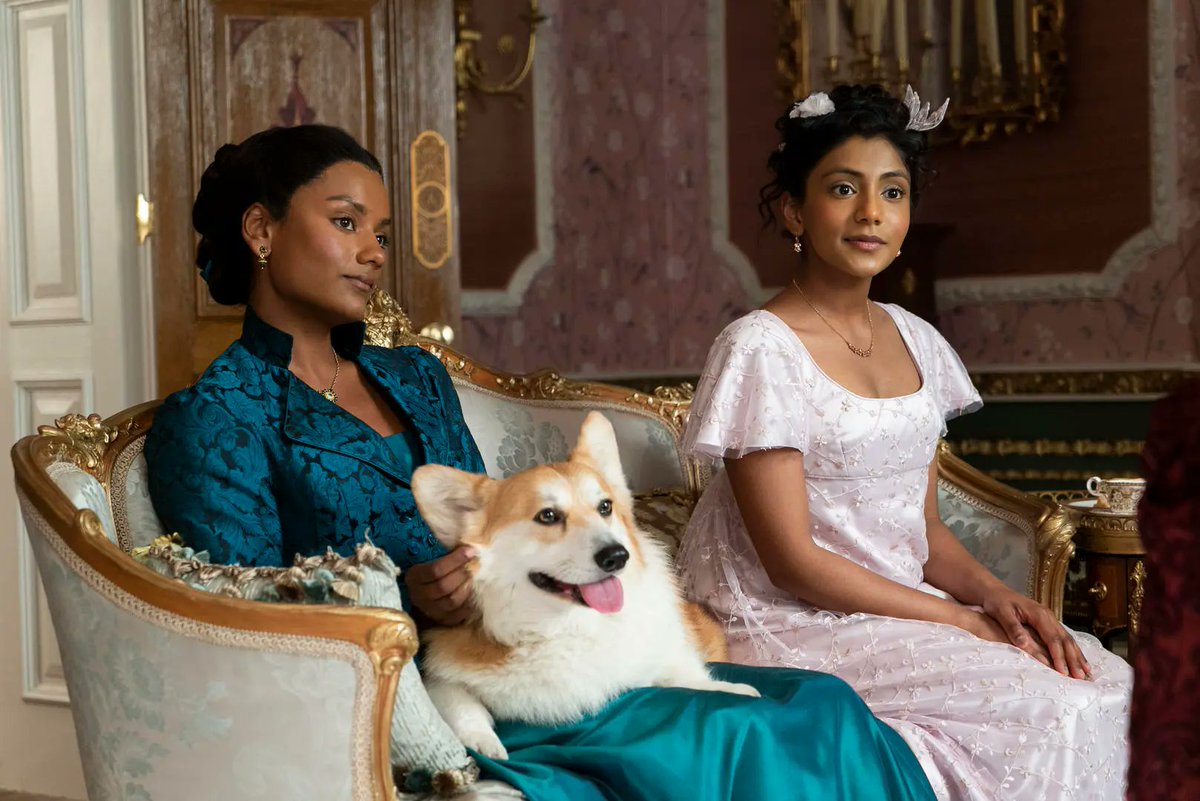
I’ve noticed that Newton the corgi is a big deal in the new season of #Bridgerton and I realised I’ve never seen a corgi mentioned in any sources from the 18th + early 19th centuries. It got me thinking… 

Would people living during the Regency period even recognise a Welsh herding dog with short legs as a distinct type of dog? Would they have called it a ‘corgi’? Would a dog owner keep a corgi as a pet rather than as a working animal?
(Corgi megathread incoming)
Of course, Bridgerton is deliberately anachronistic by choice and no period drama can ever be truly historically accurate. Almost all dog ‘breeds’ have changed dramatically in the last 200 yrs. Early c19th toy spitzes aren’t the same as today’s purebred Pomeranians.
The books’ author, Julia Quinn, acknowledges herself that corgis weren’t officially recognised as a breed until a century later. She also repeats a popular claim that they’ve been in Wales since the medieval period, but I’ve not found any evidence to back this up.
(There’s some speculation they descend from short continental dogs brought over by Flemish immigrants in the medieval period, but today’s corgis are most closely genetically related to other British herding dogs like collies.)
Anyway, onto the period that Bridgerton is set in—the 1810s. No corgis appear in the lost dog adverts of London papers around this time. They don’t feature in pet portraits. You probably wouldn’t find one as a pet in London’s West End. But what about in Wales?
William Salesbury’s 1574 English-Welsh dictionary translates ‘korgi’ as cur dog. Dictionaries from the Georgian period also present ‘corgi’ as a direct translation of ‘cur dog’. But they don’t make distinctions between the corgi and other curs (inc. sheepdogs) in general.
Note: Cur is quite a difficult word to define. Essentially, it means a dog of indiscriminate and/or indeterminate breeding. It was also a popular insult. Of all dogs, curs had the least worth, although they did perform important tasks (including guarding and herding).
Finally, in 1824, an etymologist suggests that corgi actually derives from ‘corr’ + ‘ci’ – literally, ‘dwarf dog’. But sadly there’s no further description of these dogs as a group.
In 1768, the Welsh natural historian Thomas Pennant mentions corgis in his study of British animals. But Pennant’s ‘corgi’ isn’t a dog! He identifies the corgi as the ‘cur fox’ – a small variety of fox with a black-tipped tail.
According to Pennant, the corgi ‘lurks about hedges, out-houses’ and is more dangerous to poultry than any other fox. If these corgis weren’t regularly culled ‘the number of these animals would soon become intolerable’.
This description was accepted well into the 1810s. Perhaps the corgi fox was named after a similar looking ‘landrace’ dog it shared its territory with, but no one mentions it. Cur foxes aside, corgis don’t make any appearances in books about animals and dogs during this period.
So, you probably wouldn’t find a corgi as a family pet in either Wales or in Mayfair during the early nineteenth century. And the only ‘corgi’ an educated Englishwoman would have been familiar with was the corgi fox.
That’s not to say that the ancestors of today’s corgis weren’t living and herding in Wales during this period. 50 years later you do begin to find descriptions of the sorts of dogs we recognise today.
(‘Welsh Corgi’, lithograph by R. Tuck & Sons, c.1880)
(‘Welsh Corgi’, lithograph by R. Tuck & Sons, c.1880)

But none of this really matters — Newton is adorable. I find it more interesting that dogs appear in the TV series in ways people from the 1810s would recognise and understand.
Queen Charlotte’s lovely Pomeranians indicate wealth, luxury and elite femininity, but also her emotional isolation and failing marriage. Other lapdogs perform the same work in c18th novels.
As for Newton the corgi — early c19th dog owners recognised and respected the ‘sagacity’ of their dogs and considered kindness to animals to be an important attribute in people. Suitors often joked that they had to win the affection of a lady’s pet if they were to win her heart.
Tl;dr: Dogs are historically specific, although breed myths and pop culture can suggest otherwise. You wouldn’t find a corgi promenading around Hyde Park in the 1810s. But the way we write about dogs and what they say about people has a very long pedigree.
Just to add — here is a photo @acdalison has found of a vintage show corgi from the 1920s
https://twitter.com/acdalison/status/1507989193544421381
Don't suppose anyone knows Middle Welsh and could translate the historic uses of the word corgi here?
Caniculus translates to puppy or little dog, which could suggest that short corgis had emerged as a type by 1604.
Entries from the Geiriadur Prifysgol Cymru (thanks @dyddgu)
Caniculus translates to puppy or little dog, which could suggest that short corgis had emerged as a type by 1604.
Entries from the Geiriadur Prifysgol Cymru (thanks @dyddgu)

• • •
Missing some Tweet in this thread? You can try to
force a refresh



